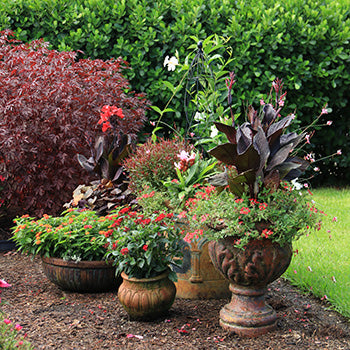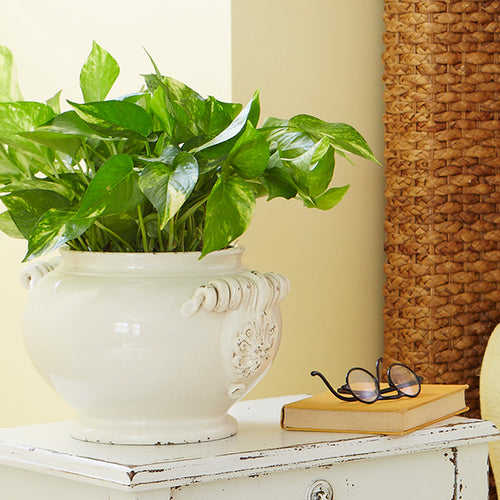By Doug Jimerson
As the days lengthen and the temperatures climb, your garden should be busting out all over. Here's a list of things to do this month to make your June garden shine.

1. Plant Groundcovers in Your June Garden
If you have a shady or sunny spot where your lawn struggles, replace the tired turf with easy-care, colorful groundcovers. These hardy perennials come back every year and are tough enough to withstand just about any conditions. For shady landscapes consider:
- Ajuga
- Epimedium
- Ferns
- Lamium
- Pachysandra
- Vinca
Learn how to plant groundcovers!
2. Plant Summer Crops
In the South there’s still time to plant vegetables such as okra, sweet potato, southern pea, sweet corn, and lima bean. These plants require the long, hot growing season typical of southern gardens. In the North, June is a good time to plant fast-growing crops such as green beans, basil, dill, and Swiss chard.Tip: Soil moisture is especially important for seeds to sprout. Keep newly planted vegetable beds slightly moist at all times. A soaker hose is the best way to irrigate your crops; it delivers water directly to the plant roots. And, unlike a sprinkler, a soaker hose won’t waste water by spraying if onto paths or driveways.
3. Bring on Boston Ferns
Wildly popular since they were first discovered in the late 1800s, Boston ferns lend themselves to a wide range of uses in your home or garden. For example, when grown in hanging baskets, Boston ferns add a touch of gentility and grace to a front porch or pergola. They’re also lovely planted in large urns flanking an entry or walkway. Indoors, Boston ferns are prized for their easy elegance and lush green color. Boston ferns are also a lot tougher than they look. Just make sure they don’t dry out and they’ll flourish in style.Tip: Keeping a Boston fern happy means making sure it is well hydrated. Instead of watering from above try sinking the fern, pot and all in a bucket of water. Let the fern sit long enough until air bubbles stop rising from the water. That means the soil ball is completely soaked and the fern is well water for a few days.
Get more ideas for using ferns!
4. Go on Bug Patrol
Throughout most of the country, June marks the unofficial start of the insect season. The best way to protect your plants is to go on bug patrol, walking through your garden in order to spot insect pests before their populations explode. (To identify insects, buy an insect field guide to help you tell the difference between a bad bug and a good bug.) Examine the tops and bottoms of leaves and branches that look discolored or misshapen. Check for aphids -- they look like grains of salt and pepper attached to new growth. Then, if you find a trespasser you can take appropriate action.You can control a wide variety of insect pests by spraying them with insecticidal soap. Look for this organic control at your local mass merchant or garden center.
Tip: Avoid blanket spraying your garden with insecticides. You’ll do a lot of damage by killing off beneficial insects and pollinators, such as bees and butterflies. Identify the pest you’re after, and focus your attack.
5. Repot Houseplants
Early summer is a great time to give houseplants a new lease on life by repotting them in larger containers with fresh soil. Gently tap the plant out of its current container, brush away excess soil, and replant in a pot that’s slightly larger then the old one. If the roots are growing in a circular mass, pull them apart a little before you replant. Use a potting mix. Never use soil from your garden to fill a container because if it dries out it will become rock hard.Tip: Houseplants like to go on vacation! Move them outdoors to a shady, protected location for the summer and they’ll thank you with abundant new growth. Bring them back indoors in the late summer or early fall before the first frost.
6. Attract Hummingbirds
Bold, bright, and fun to watch, hummingbirds will flock to your yard if you include plants they feed on in your garden. Because hummingbirds are nectar-feeders with long beaks, they prefer plants with tubular blooms. They are attracted to red or orange flowers, but will readily feed on any color flower as long as it has nectar. Some hummingbird favorites include:- Butterfly bush
- Cardinal flower
- Fuchsia
- Geranium
- Hollyhock
- Honeysuckle
- Lantana
- Mandevilla
- Morning glory
- Nicotiana
- Penstemon
- Petunia
- Salvia
- Trumpet vine
7. Add Support
If you haven’t done so already, stake/support floppy perennials such as Oriental lily, hollyhock, and delphinium. These tall plants can topple in high winds -- especially when they are in full bloom. Insert a wooden or plastic stake into the ground about 4 to 6 inches from the crown of the plant. Your stake should be about a foot taller then the expected height of your plant and be long enough to secure it into the ground. Pound the stake into the ground with a mallet or hammer. Then, using plant ties, strips of panty hose or raffia, make a figure-8 loop around stake to attach the stem of the plant. The stem should be held in place securely, but not tied so tightly that it can’t move. Add additional ties every 6 to 8 inches as the plant grows taller.Tip: For mounding perennials such as peonies, use four stakes placed around the plant. Tie them together with string to create a basket-like support. Green stakes and string will quickly be camouflaged by the plant’s foliage.
8. Pinch Your Plants
Removing fading flowers as they appear is one of the best ways to keep your annual flowers blooming. Although many species are self-cleaning -- which means they drop their own blooms -- you’ll get better performance if you clip away spent flowers, especially with plants such as cleome, gaura, euphorbia, geranium, verbena, petunia, alyssum, lantana, and salvia.Tip: Pinching or clipping away old blooms is the easiest way to deadhead. But, you can also use a handheld grass clipper if you want to shear back an entire plant, particularly those with tiny flowers such as alyssum.
9. Mix Foliage and Flowers
Looking for a colorful and memorable container combination? Just mix houseplants with annual flowers! Plants such as philodendron, pothos, aglaonema, snake plant, and anthurium mix well with shade-loving annual flowers such as begonia, New Guinea impatiens, caladium, torenia, and coleus. Or, try a pot with all indoor plants mixed together. That way, once fall arrives, you can move the entire container indoors to enjoy all year long.Tip: Annual flowers and houseplants have similar requirements -- that’s what makes them such good partners. They need warm, moist conditions, and an occasional feeding during the summer to keep them in top form.
Learn more with our 1.5-minute-long video!
10. Go Aquatic
Create an oasis in your backyard with a tabletop water garden. All you need is a waterproof container and a few aquatic plants. Papyrus, canna, equisetum, juncus, and elephant ear are just some of the dramatic aquatics you can grow in a few inches of water. Simply cover the soil the plants are growing in with a layer of pea gravel. Then, sink the plants, pots and all, into your container. The gravel will keep the plants in place and will prevent the soil from washing away.Tip: To keep mosquitoes from breeding in your water garden, add a few small goldfish. They’ll eat the mosquito larvae before the mosquitoes can eat you!
June Gardening Questions?
We love to talk to other gardeners. Email us your questions and we'll have one of our experts get back to you!

















